|
A collection is built little by little, object after object almost without knowing that we have just put our fingers in a gear...
And then there is the joy of discovering the unexpected object that we miss, then the wonder when it arrives and we open the package.
In chronological order of arrival of the calculators, I have described here my feelings, my surprises...
So the history of the construction of a collection, day after day...
|
 |
My first TI... |
|
While I have been working as a programmer since 1974, I was tempted, at the time, to acquire one of the programmable hex cards (Kim1, MK14 .. .), cards nicknamed "university cards".
But, in 1979 I chose a TI-58C, unrelated to my initial temptation.
This TI-58C will be purchased with a PC100C printer and other accessories ...
It will be the beginning of a devouring passion still today ... a first love that lasts!
(See page My TI-58C)
|
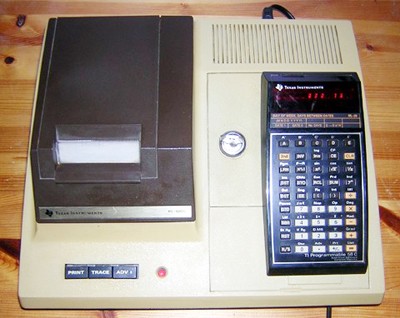 |
 |
My son's TI... |
|
In 2020, I found my son's TI-82 Stats.fr calculator, the one he used in high school eleven years previously (2009) and I tried it ...
In addition, a cable allowing connection to a PC accompanied the TI-82 Stats.fr ...
I not only had the surprise to find the same sensations and the same pleasure that forty years ago when I discovered my TI-58C.
Now it is no longer my son's TI
... but mine: my second TI !
(See page The TI-82 Stats.fr)
|
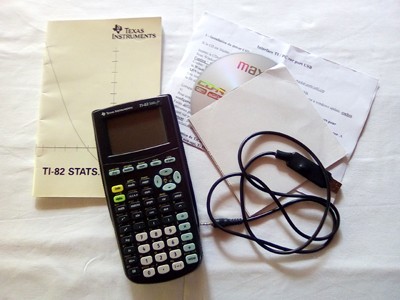 |
 |
The TI "birthday"... |
|
For my 66 years (2021), I received a TI-66 calculator as a gift.
So I started to discover this new TI-66.
I find it very beautiful, light, fine ...
But a little disappointment: I don't have the PC200 printer and there are some differences with the TI-58C:
no library modules,
no HIR instruction,
no DSZ instruction on registers greater than 9 ... which was done by cheating with the TI-58C.
I'm still happy to have this lovely little gem.
|
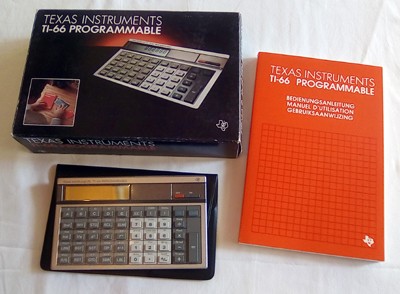 |
|
...and the others |
|
After finding the TI-82 Stats.fr and receiving the TI-66 as a gift, I started looking for other TI programmable calculators ...
... with the desire to find the TI-59 that I had never had.
And I ended up finding ...
|
 |
TI-62 |
|
For my 62 year birthday it was too late ...
But in July 2021, I made up for it and found a new TI-62 in its original box, accompanied by its manual still in plastic.
I find it as beautiful as the TI-66, and I wonder if I will not go looking for some TI Galaxy calculators, even non-programmable.
|
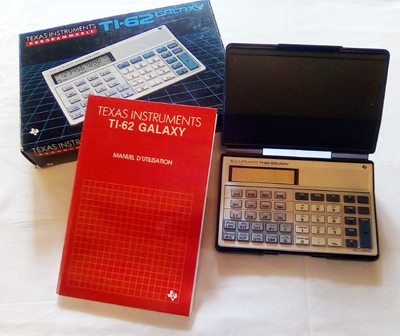 |
 |
TI-57 II |
|
In 1978 I hadn't been attracted to the TI-57 at all ...
And I regret it a little today.
I found a new TI-57 II in its original box. (August 2021)
It is very pleasant to use and I find it quite aesthetically as well.
|
 |
 |
TI-59 |
|
Finally, in August 2021, I unearthed the famous TI-59 ...
She was hiding in Spain and seemed to be waiting for me.
The young woman who was willing to sell it to me wanted an exorbitant price because of the affection brought to this calculator which belonged to his parents.
We ended up finding a reasonable and satisfying deal for all of us.
New in appearance, having been used very little, the TI-59 was almost complete since all that was missing was the manual (found elsewhere).
It was in its original box with:
its plastic case,
its power supply,
the Master module with its small documentation,
some new magnetic cards,
a drive cleaning kit,
and several programming sheets.
The box had suffered, but the calculator, and its battery pack, showed no signs of corrosion.
It worked very well ... then each time the player is switched on, the reader runs continuously and the display flashes ...
I will try to solve this annoying problem ...
In any case, thank you Maria del Mar !
|
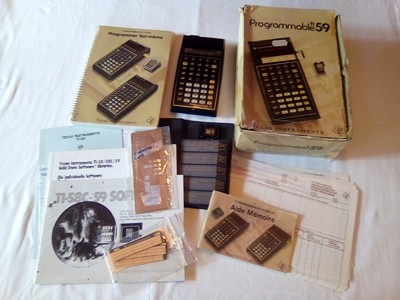 |
 |
TI-95 |
|
As soon as the TI-59 arrived, I found a new TI-95 in its original box (and shipping box Texas Instruments !).
|
|
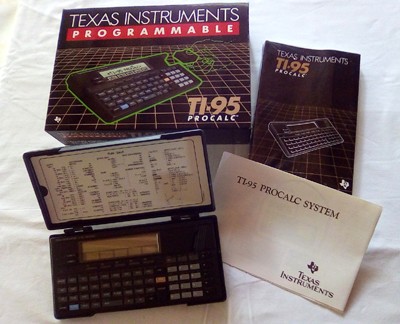 |
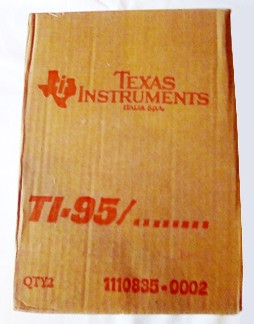 |
|
A magnificent machine !
The TI-95 is a big size: 96 x 204 x 25 mm, not really a "pocket".
But what a machine ! A real "pico-computer".
The manual contained in the box is in German, I have to print one in French and bind it.
All I will need is the tape recorder interface to record the programs, plus the PC-324 printer and the math module.
|
 |
TI-57 LCD |
|
At the end of August 2021, I found, also in Germany, a TI-57 LCD.
Unfortunately she suffers from the known disease of these calculators: the crazy keyboard !
I knew that Texas Instruments had reviewed the technology of the keyboards of the TI-55 II, TI-57 LCD, BA-55 to replace them by TI-55 III, TI-57 II, BA-54 with a better keyboard, but I took the risk of 'buy a TI-57 LCD.
So I'll have fun with the TI-57 II.
Despite everything, the TI-57 LCD remains very beautiful with pretty colors.
|
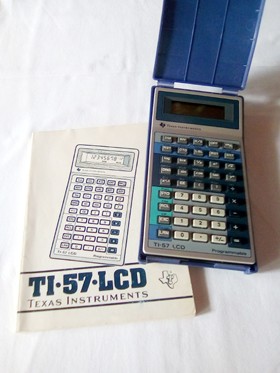 |
|
and after... |
|
After my acquisitions this summer 2021, I am missing calculators from the lines 57 and 58 / 59 ...
It is not easy today to find some models in working condition and a calculator that does not work does not really interest me.
And my preference is for calculators complete in their original box with the manual in French, possibly in English.
My criteria therefore drastically limit my research.
So now I am missing one of the following calculators:
SR-52, SR-56, TI-57, TI-58 and TI-88 ...
For the last one, the TI-88, I'm not dreaming ...
Considering the rarity !
For the others, I find some TI-57 and TI-58 quite often with the original box, but without the charger or without the manual and each time not functional!
As for the SR-52 and SR-56 the very rare finds are real ruins!
Maybe I'll let myself be tempted by a "cousin", another programmable TI:
TI-65, TI-68, TI-60, TI-60X, TI-67, TI-51III, TI-55II, TI-55III, TI-56, < b> TI-42MBA, BA-55, BA-54, TI-55, TheMBA, TI-53 ...
|
 |
 |
TI-56 |
Completing my small collection of the line of 57/58/59 "classic" programmable , this "cousin"arrived from France on September 4, 2021.
This TI-56 is in the aesthetic line of the "slanted" calculators quite similar to the TI-57 II.
It is however 8 steps more than the TI-57 II : [2nd] [Part] [1] gives 56.1 on the TI-56 instead of 48.1 for the TI-57 II .
Normal, the TI-56 is not another version of the TI-57 IIbut the European version of the TI-55 III !
Why name it 56in Europe and 55 IIIin the United States ???
|
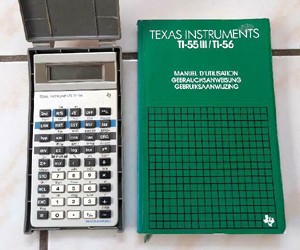 
|
|
 |
 |
TI-60 |
Completing my small collection of the line of 57/58/59 "classic" programmable , this "cousin"arrived from Germany on September 4, 2021.
This TI-60is in the aesthetic line of the "slanted" calculators but of a black color making it a little more "class".
Many unusual functions give it a certain appeal:
conversions of imperial units (gal, lb, in) to metric units (l, kg, cm),
use of hexadecimal and octal,
and many others functions (statistics, integration, ...)
Note that the partitioning is done in hexadecimal: [2nd] [Part] [C]for 12 data memories, and the addressing of the registers is also done in hexadecimal: STO Ainstead of STO 10 , STO Binstead of STO 11 .
|
 
|
|
 |
TI-67 |
|
To complete the "60s" series I bought a TI-67.
Almost new in its original box with its small booklet, the TI-67 has the shape of a Galaxy but is not framed in metal like 62 and 66.
It is entirely made of plastic and does not fit in a pouch or in a box but has a cover in which it slips like a drawer. (As TI "graphing" calculators will do later)
Its presentation and colors are reminiscent of a calculator from a competing brand ... ("High Price" ...)
The handling is pleasant and I am positively surprised.
My first program is written in a few minutes and gives me real pleasure: the language is a mixture of old AOS language and a simulated TI Basic.
The program is written on one line, the instructions being separated by the character ":" (colon).
The program is not measured in number of steps but in bytes.
The TI-67 has 90 memories and 1536 bytes available for programs.
The numerous functions: mathematics, statistics, formulas, sequences ... and the programming methods presage of future "graphics" calculators.
Everything is already there ... except the graphic screen !
The TI-67 is a great find and I feel like I'm going to have a lot of fun.
|


|
 |
TI-55 / TI-55 II / TI-55 III |
|
The TI-55, TI-55 II, TI-55 III arrived together on the same day, the first day of fall.
All three came from the United States, the TI-55 from Minnesota, the TI-55 II from Texas and the TI-55 III from California.
The TI-55 was in its original box with the Owner's manual, the "Calculator Decision-Making Sourcebook", the bag and the charger (US plug, 120V).
Everything was new, never used, and the batteries charged without problem, I just had to use a French charger (French plug, 220V).
The TI-55 is beautiful, really brand new! And very pleasant to use.
On the three calculators I am starting my first attempts to compare behavior.
I know that the programmability of the TI-55 is very light since, in addition to a program size limited to 32 steps, it is not possible to use other branching instructions than the classic RST.
But for the TI-55 II and TI-55 III the behavior of the RST instruction in a program presents a very important drawback.
Indeed if on the TI-55, RST makes it possible to continue the execution of the program after returning to the step 00 of the program (which allows a simple loop), on the TI-55 II, TI-55 III (and therefore the TI-56) execution stops after returning to step 00.
No loops possible on these calculators: the documentation is unfortunately very clear on this principle of stopping at step 00 !
|
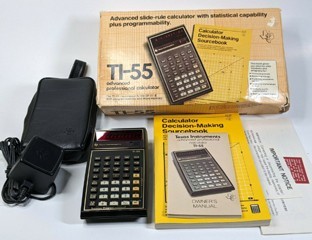

|
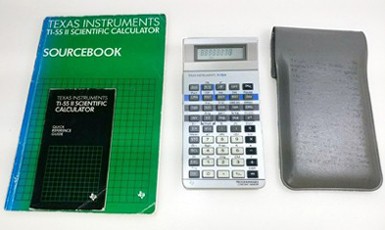 
 
|
| |
But...
In reality my new TI-55 II can be qualified as a rare calculator.
In fact, it is not really a TI-55 II : it is a TI-55 III of the first series which however still uses the designation TI-55 II.
These so-called TI-55 IIs were produced in Taiwan between October 1984 and March 1985.
Mine was made in Taiwan in October 1984.
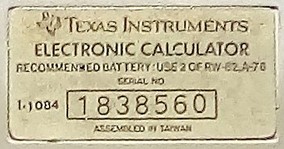
|
 |
 |
TI-65 |
|
With the TI-65 I expected to be surprised ... and I was not disappointed!
I knew that the most surprising feature on the TI-65 is a per-second stopwatch which is managed using the TUp or TDn instructions.
I knew the TI-65 had a lot of programming features:
unconditional branching (GTO),
conditional branching (x<m, x=m, x>m),
the labels (LBL),
the subroutines (SBR, RTN),
a DSZ loop statement,
...
and many other possibilities (decimal / octal / hexadecimal, conversion of measurements, integration, statistics ...)
Then two function keys F1 and F2, dynamic memory allocation and hexadecimal numbering of the data registers completed the surprise.
But the most astonishing remains the internal codification of the programming instructions: LBL F1 is displayed "2nd53.53", the instruction x=m is displayed "3rd 43", GTO 2 is displayed "2nd 54.2" ...
(see the factorial calculation program)
|
 |
 |
The MBA / BA-55 / BA-54 |
|
The TI "The MBA" arrived from the United States (Garland, Texas) along with the small booklet serving as a manual, which arrived from Canada (Vancouver, British Columbia).
And by the greatest of luck, the same day arrived the BA-55 from the United States (Elkins, Arkansas) and the BA-54 from Canada ( Montreal, Quebec).
The TI "The MBA" is of the "Majestic line" style like the TI-55 and TI-57, a style that I really like. But it is distinguished by a "Gold" color background instead of the traditional black background.
The BA-55 and BA54 are "Slanted" like many other calculators from the same era. < BR>
The BA-54 is the replacement calculator for the BA-55 following the disaster of the keyboards of the first "Slanted "(inclined).
(Just as the TI-55 II, TI-57 LCD ... were also replaced)
The TI "The MBA" does not have its original batteries (BP7) but has been adapted to receive a 9V battery (6LR61). It works very well. But ...
On the programming side, as expected, the TI "The MBA" does not have great possibilities just like the BA-55 and BA-54 .
That none of the three have trigonometric functions is not surprising, but the lack of parentheses on the BA-55 and BA-54 confuses me a bit. .
I'm not going to have the most fun with one of these three calculators!
|
 |
|
 |
TI-68 |
|
With the TI-68 I expected not to be surprised ... and I was not surprised!
I knew that for the TI-68 it is better to talk about "formulas" rather than programs since no sequence of instructions is possible, just the definition of formulas.
It is nevertheless very rich in functions and I will delve into its manual.
As for the TI-60X, which has no relation to the TI-60, it is only a derivative version of the TI-68 with a seemingly bizarre but nevertheless pleasant display.
Despite everything, I found these two calculators very nice to use.
|
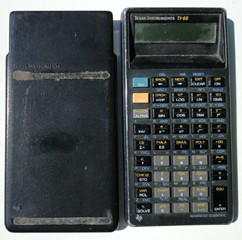 
 
|
 |
TI-53 |
|
In its original box, the TI-53 is as I expected.
With a single data memory and 32 program steps and the impossibility use branching instructions other than the classic RST, the TI-53 is not the most programmable of programmables...
But the documentation, a user manual and an accompanying application "library", offer surprising examples of small programs.
I think against all odds I'm going to spend some time studying all of these programming examples.
|
 
|
 |
SR-56 |
|
The SR-56 is of a "Classic" format which I find very pleasant.
It did not light up but the batteries (BP1) did not appear to be corroded. I didn't have the charger so I chose to use my PC-100C printer to charge the batteries.
Two hours later I installed these batteries in the SR-56 calculator ... it works wonderfully !
I hastened to grab my first program. Awesome !
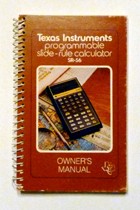 
|
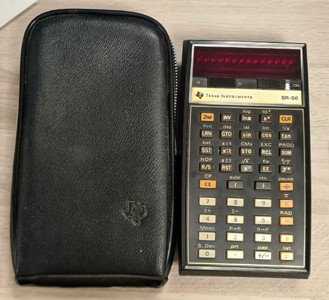
|
 |
TI-57 |
|
The TI-57 batteries were completely corroded. So I put an adapter for 9V batteries (6LR61) and of course a 9V battery. (You have to reverse the wires: red on black and black on red.)
The TI-57 works like the first day!
I didn't have a case for this calculator, I found one that came from Hungary in 4 days!
I will now be able to use the many programs for TI-57 published at the time...
|
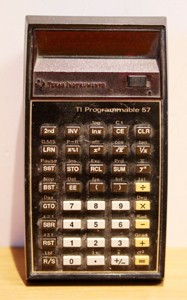

|
 |
TI-51 III |
|
When the TI-51 III arrived I had no surprises knowing that TI-51 III was just the European name for the TI-55, nothing more, nothing less.
But I'm glad because it was more difficult to find one TI-51 III than its American version the TI-55.
|
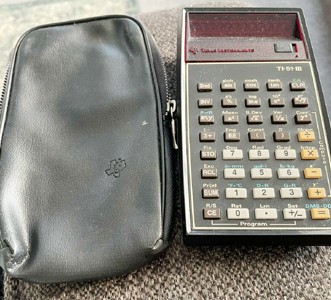
|
 |
 |
and also... |
|
A second TI-57
Why still a second TI-57 ?
Because I just wanted to verify that replacing the BP7 battery pack with a 9V battery adapter (6LR61) was still the solution for a TI-57 that was declared non-functional.
 And it worked again: the TI-57 came out of the coma it had been in for many years.
And it worked again: the TI-57 came out of the coma it had been in for many years.
(I was also won over by the unusual pouch.)
|
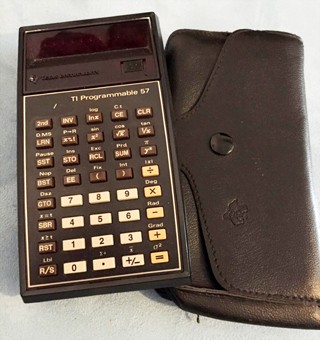
|
|
A second TI-57 II
Same question : why still a second TI-57 II ?
The answer is in the photo: bottom left on the calculator...
|
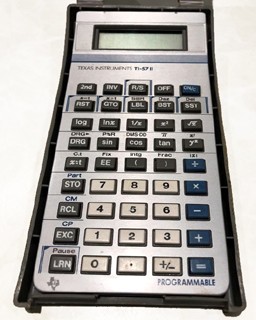
|
 |
SR-52 |
|
My SR-52 arrived with its unfortunately defective AC9900/E Adapter / Charger.
In addition, the BP1-A battery pack was completely corroded and one of the calculator's internal contactors was broken.
Despite all of these misfortunes I used a universal adapter and the SR-52 is back to working order.
I was surprised by its "plump" side: it is bigger than a TI-59 (its bag is double in thickness).
I quickly wrote my first programs with an unexpected surprise: the lack of program step economy !
STO (RCL, EXC...) takes 3 program steps: 42 00 01 instead of 42 01 and GTO address costs 4 steps !
But I find all the pleasure of old TI...
|


|
|
 
 
 
 
|
|
 |
 |
TI-58 |
|
With the TI-58 I finally complete the legendary trio: TI-58, TI-59 and TI-58C !
I already had the TI-59 and TI-58C but not the TI-58 ...
It's not the most exciting of the three: no card reader and no constant memory.
It dates from 1979 and it still works!
So I'm going to play around with it for fun, but not too long: I don't want to re-enter the same program every time I turn it on again.
And I will not fit the longest programs ...
|
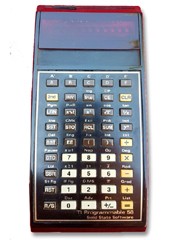

|
 |
TI-55 III |
| |
I already had a TI-55 III, so why a second one ?
Because the history of the TI-55 III is a little bit complicated...
... and because I already had several TI-55 II which are not called like that but are nevertheless TI-55 III.
All was started with the TI-55 II whose faulty keyboard forced Texas instruments to review its copy.
The TI-55 II that I thought I had in my collection was not actually this TI-55 II with a poor keyboard but a TI-55 III from the first generation manufactured in Taiwan in 1984 by Inventec and stamped TI-55 II (with just one missing "I").
Then I got a TI-55 III made in the USA in 1987 which I believed to be the only one real TI-55 III.
I had just forgotten the facetious side of Texas instruments...
Because there was a TI-55 III absolutely identical to the TI-55 II of the first series but with the missing "I" finally added. This TI-55 III was also manufactured in Taiwan (Inventec) but in 1985.
This whole TI-55 III story could have been ended there, but...
The TI-55 III has become the TI-56 in Europe, just for marketing.
The first jet of the TI-56 was manufactured in Taiwan in 1985 by Compal Electronics. Then the production was continued in Italy.
There are 3 different versions of the TI-56...
If I recap, today I have 6 "TI-55 III":
one TI-55 II "Taïwan I-1084" (with one missing "I"),
one TI-55 III "USA LT 0187",
one TI-55 III " Taïwan I-0685",
one TI-56 "Italie RCI 3587",
one TI-56 "Italie RCI 4487",
one TI-56 "Taïwan C-0585".
Until my next discovery !
|
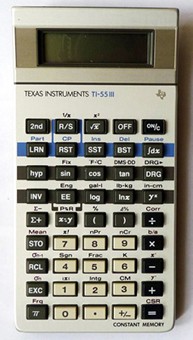
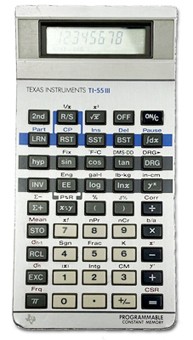
|
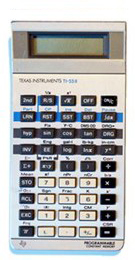

|
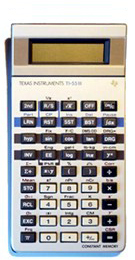

|


|


|
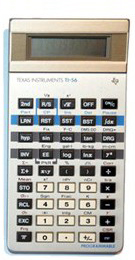

|


|
TI-55 II
"Taïwan I-1084" |
TI-55 III
"USA LT 0187" |
TI-55 III
"Taïwan I-0685" |
TI-56
"Italie RCI 3587" |
TI-56
"Italie RCI 4487" |
TI-56
"Taïwan C-0585" |
|
 |
TI-55 II |
|
The TI-55 II, the real one made in the USA in 1984, does not and cannot look like a TI-55 III !
"Slanted" of the first generation, it is distinguished by its infernal keyboard ... (just like the TI-57 LCD and BA-55)
|
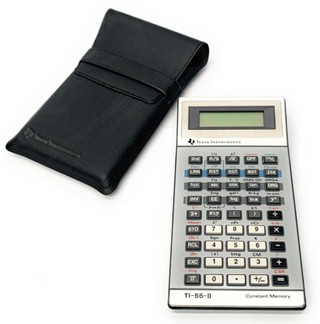

|
 |
TI-57 II |
| |
| I already had a TI-57 II, so | why a second one ? |
| why a third one ? |
| why a fourth one ?... |
|
|
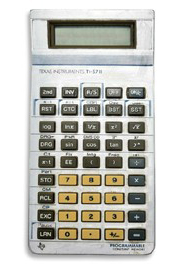 
|
 
|
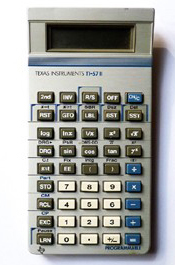 
|
 
|
DATE
CODES |
MADE
IN... |
"TEXAS" LOGO
POSITION |
BOTTOM RIGHT
TEXT |
NUMBER
KEYS |
ARITHMETIC
KEYS |
 C-0385 C-0385 |
Taiwan |
at the bottom left |
PROGRAMMABLE
CONSTANT MEMORY |
yellow |
grey |
 C-1184 C-1184 |
Taiwan |
at the bottom left |
PROGRAMMABLE
CONSTANT MEMORY |
white |
blue |
 RCI 3885 RCI 3885 |
Italy |
at the bottom left |
PROGRAMMABLE |
white |
blue |
 RCI 3587 RCI 3587
 RCI 0888 RCI 0888
 RCI 3186 RCI 3186 |
Italy
Italy
Italy |
at the top right |
PROGRAMMABLE |
white |
blue |
|
|
 |
TI-53 |
| |
I already had a TI-53, so why a second one ?
Because the first, dated 1979, is from the generation of "Slimline" (ultra-flat) calculators while the second, dated 1985, is from the "Slanted" !
(There is another TI-53 "slanted" made in Italy from 1986... not found !)
|
|
|
 |
TI-57 LCD |
| |
I already had a TI-57 LCD, so why a second one ?
Because my first, dated 1983, made in Italy is not exactly the same as my second, dated 1982, made in the USA !
|
|
|
 |
TI-68 again... |
|
A second TI-68 has arrived... (by plane from Ottawa - Thanks Andrew)
A version 2 of the TI-68 : the one where plastic replaced metal (and screws disappeared) !
|
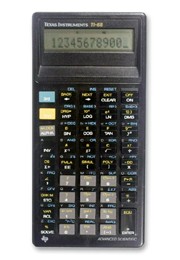 
|
 |
TI-60 again... |
|
A second TI-60 has arrived...
A version 2 of the TI-60 with the mention "Advanced Scientific" !
|
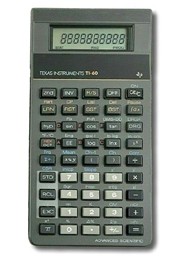 
|
 |
TI-62 again... |
|
Why a second TI-62 ?
Just for fun and a great opportunity...
(less than 10 )
|
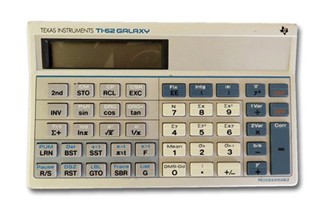 
|
 |
A third TI-57
|
|
Why still a third TI-57 ?
This is the first version of the TI-57, assembled in Italy from 1977, with the text "Texas Instruments" and the logo printed on a metal plate stuck on the TI-57.
|
 
|
 |
Radio Shack EC-4000 |
|
A Radio Shack EC-4000 calculator arrived from Belgium in early 2022...
However, I do not deviate from my center of interest: Texas Instruments programmable calculators !
The Radio Shack EC-4000 was manufactured in Lubbock, Texas (USA) in 1978.
It's a real TI-57 and only the exterior aesthetics are slightly different.
|
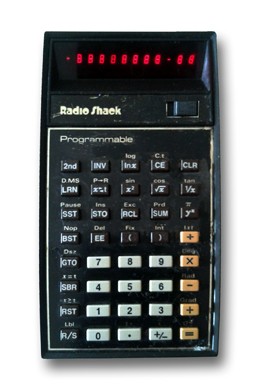 
|
 |
My "Fr" graphing calculators... |
|
My son's TI-82 Stats.fr calculator was not the first graphic calculator in French version produced by Texas instruments ...
This one, black and dating from 2009 was preceded by another TI-82 Stats.fr also in French version but red and dating from 2006.
So I gave in to the temptation to have a second TI graphic in French version (with a 60-page booklet and the complete manual of 260 pages).
I already had a "Graylink" cable to connect the TI-82 Stats.fr calculator to my PC and exchange programs between the emulator and calculator.
But I didn't have the cable to connect the two TI-82 Stats.fr to each other...
After some research, I found this cable on several merchant sites at a price varying between 15 and 35 Euros...
Then I discovered this cable sold with a TI-83 Plus.fr with which was also supplied a "SilverLink" cable, a booklet of 60 pages and the CD. All for 12 euros!
I did not hesitate! And so I acquired my third TI graphic in French version.
There will therefore have been these 3 TI graphics calculators produced in French version :
|
the TI-82 Stats.fr from 2006 (red),
the TI-83 Plus.fr from 2008,
the TI-82 Stats.fr from 2009 (black).
|
Followed by :
|
the TI-76.fr from 2009,
the TI-84 Pocket.fr from 2011,
the TI-83 Plus.fr from 2013.
|
With my three TI graphing calculators, I finally satisfied an old fantasy that I had not yet been able to satisfy with my emulator and my TI-58C : exchange programs and data between the emulator and calculators but also from calculator to calculator.
(For the TI-58C, I do not despair! I know that other people, more competent than me, are working to resolve this problem.)
|
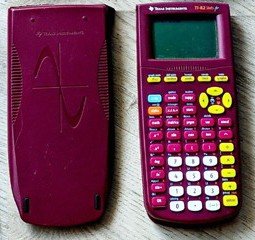

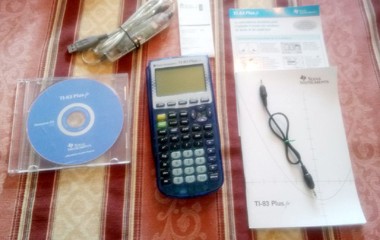
|
 |
TI-92 the unexpected... |
|
I had not considered looking into the TI-92 which did not match my search criteria.
Then the opportunity, accompanied by a hint of curiosity, brought about the temptation to which I gave in.
A TI-92 was therefore added to the oldest calculators ...
It was provided with
a 92+ module and its 244-page documentation,
the User Manual of more than 500 pages.
So I'm going to have a lot of reading for my long winter evenings ...
|

|
 
|
 |
and finally... |
|
Many more will be added...
Either because they are missing from my collection like the TI-42 MBA (European version of the TI The MBA) or the TI-68 from 1995 (made in China).
Either because I already had them but I tried and won very very low bids for calculators in perfect condition that I couldn't resist (TI-57 LCD, TI-60, TI-55 II).
Either because they were sold complete in their original box at an unbeatable price (TI-53, TI-57 LCD).
Either because I liked them and they seemed interesting to test (TI-82 Plus, Voyage 200).
And there I thought I had made the full turn of what I could have, except for the "missing" ones like the TI-88 that I will never find.
Then I "stumbled upon" an article that spoke of calculators using, against all odds, direct algebraic notation: three Hewlett Packard !!!
The first two, the programmable HP 20S (Scientific) then its sister the HP 21S (Stat/Math), were followed by the most incongruous HP : the HP 35 which can be used in Polish notation but also in direct algebraic notation.
I succumbed to the three... which have been added to my Texas Instruments collection...
I had chosen to be "Texan" since my TI-58C in 1980 and although I had worked on Hewlett Packard computers (HP3000 and HP_UX) for about ten years, I never thought I could acquire calculators HP...
|

|








